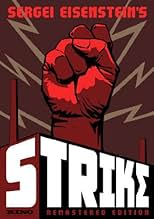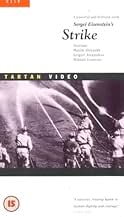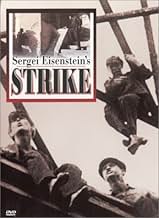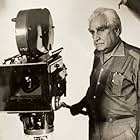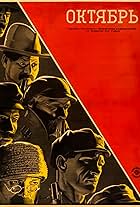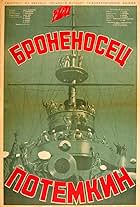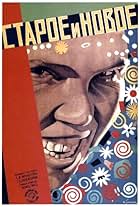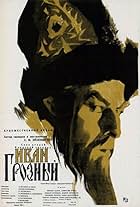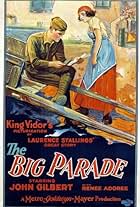IMDb RATING
7.6/10
8.8K
YOUR RATING
A group of oppressed factory workers go on strike in pre-revolutionary Russia.A group of oppressed factory workers go on strike in pre-revolutionary Russia.A group of oppressed factory workers go on strike in pre-revolutionary Russia.
Leonid Alekseev
- Factory Sleuth
- (uncredited)
Daniil Antonovich
- Worker
- (uncredited)
Pyotr Malek
- Police Spy
- (uncredited)
Misha Mamin
- Baby Boy
- (uncredited)
Pavel Poltoratskiy
- Stockholder
- (uncredited)
Storyline
Did you know
- TriviaStrike (Russian: Strike (1925)) is a Soviet silent propaganda film edited and directed by Sergei Eisenstein. Originating as one entry out of a proposed seven-part series titled "Towards Dictatorship of the Proletariat," Strike was a joint collaboration between the Proletcult Theatre and the film studio Goskino. As Eisenstein's first full-length feature film, it marked his transition from theatre to cinema, and his next film Battleship Potemkin (1925) (Russian: Bronenosets Potyomkin) emerged from the same film cycle.
- GoofsThe story is set in 1903. Throughout the film, automobiles from the 1920s appear on streets. One is the 1920s auto that the worker (who stole the administrators' posted reply to workers' demands) tried to use to escape police goons during a nighttime rainstorm. When upper-class women appear, they are wearing contemporary 1920s fashions, and the popular music that's on the sound track is also from the 1920s.
- Quotes
Title Card: At the factory, all is calm. BUT. The boys are restless.
- Alternate versionsThe film was restored at Gorky Film Studio in 1969.
- ConnectionsEdited into Ten Days That Shook the World (1967)
Featured review
This is Eisenstein's directorial debut and alongside Citizen Kane it may be one of the most important debuts in the history of film showcasing a fully-fledged artistic maturity. This is a fictitious narrative-driven movie though it is very consonant with reality. As a Communist Eisenstein's aesthetics was opposed to the "bourgeois" art style that considered the artistic object as a subject of contemplation. Eisenstein advocated in theoretical terms in his books and practically with movies such as this a pragmatic vision of art. Movies should have a purpose; they should mobilize the viewer into action by filing him with emotion.
This strategy is obvious early on with the use of the motto from Lenin that links the idea of organized workers and that of social action in an equation of efficiency. The movie tries to prove that the workers are entitled to organization and that only in such a manner they could achieve their full potential. The movie focuses on the workers as a group; there are no "characters" as we have grown accustomed to seeing on screen. The collective character of the workers, though, has a very powerful emotional impact on the viewer because Eisenstein knows how to present it:
1) The workers are presented in the factory, in what would appear to Chaplin, for instance as a medium of alienation. Here, the workers seem "at home" because they are so many they balance the non-human elements expressed by the machines. More than this the brilliant montage sequences emphasize that the workers are in peace in their environment, the visual patters give a clear feeling of the strength of the united workers. Later on with the advent of sound the beauty of an industrial landscape will be extraordinarily depicted by Vertov in Enthusiasm;
2) The workers are contrasted with the fat and greedy capitalists. Their environment is luxurious and far more "human" than a factory. However, Eisenstein makes it appear as a place of sin and debauchery. The cigar smoke emphasizes the strength of the exploiter much like the smoke from the furnace shows the force of the factory. There are many correspondences between the two environments which Eisenstein later uses to achieve some of the greatest and most emotionally engaging associative montages ever displayed. One of the most impressive shows a boss squeezing a lemon to fix himself a drink while the workers are squished by the police forces trying to repress the strike;
3) Individuals predominantly appear only when they are associated with heavy dramatic scenes, the innocent worker who commits suicide ( who only functions as the dramatic instigator of the plot without any real emotion displayed for the actual character who dies even if we know his actual name; it is insinuated that a human life has a meaning only as part of larger community), the child who is killed by the police, the spies who serve as much needed humorous debouches that relieve the tension associated with the workers exploitation but that also build up tension in the sense that they show the stupidity of the bosses and of their methods;
4) The key to the movie is its pragmatics. It is after all a propaganda piece and the ending clearly shows it. The advice addressed to the proletarians not to forget is charged with emotion because it discharges a tension that has been carefully build frame by frame at a rampant pace. Even if we disengage with his doctrine we should keep in mind that Eisenstein's genius can only be acknowledged in its cultural context and related to his conception of art's function in a society. We can screen out the propaganda but we must keep the emotion in order to understand this movie today at its full power.
This strategy is obvious early on with the use of the motto from Lenin that links the idea of organized workers and that of social action in an equation of efficiency. The movie tries to prove that the workers are entitled to organization and that only in such a manner they could achieve their full potential. The movie focuses on the workers as a group; there are no "characters" as we have grown accustomed to seeing on screen. The collective character of the workers, though, has a very powerful emotional impact on the viewer because Eisenstein knows how to present it:
1) The workers are presented in the factory, in what would appear to Chaplin, for instance as a medium of alienation. Here, the workers seem "at home" because they are so many they balance the non-human elements expressed by the machines. More than this the brilliant montage sequences emphasize that the workers are in peace in their environment, the visual patters give a clear feeling of the strength of the united workers. Later on with the advent of sound the beauty of an industrial landscape will be extraordinarily depicted by Vertov in Enthusiasm;
2) The workers are contrasted with the fat and greedy capitalists. Their environment is luxurious and far more "human" than a factory. However, Eisenstein makes it appear as a place of sin and debauchery. The cigar smoke emphasizes the strength of the exploiter much like the smoke from the furnace shows the force of the factory. There are many correspondences between the two environments which Eisenstein later uses to achieve some of the greatest and most emotionally engaging associative montages ever displayed. One of the most impressive shows a boss squeezing a lemon to fix himself a drink while the workers are squished by the police forces trying to repress the strike;
3) Individuals predominantly appear only when they are associated with heavy dramatic scenes, the innocent worker who commits suicide ( who only functions as the dramatic instigator of the plot without any real emotion displayed for the actual character who dies even if we know his actual name; it is insinuated that a human life has a meaning only as part of larger community), the child who is killed by the police, the spies who serve as much needed humorous debouches that relieve the tension associated with the workers exploitation but that also build up tension in the sense that they show the stupidity of the bosses and of their methods;
4) The key to the movie is its pragmatics. It is after all a propaganda piece and the ending clearly shows it. The advice addressed to the proletarians not to forget is charged with emotion because it discharges a tension that has been carefully build frame by frame at a rampant pace. Even if we disengage with his doctrine we should keep in mind that Eisenstein's genius can only be acknowledged in its cultural context and related to his conception of art's function in a society. We can screen out the propaganda but we must keep the emotion in order to understand this movie today at its full power.
- stalker_voegler
- Mar 20, 2008
- Permalink
- How long is Strike?Powered by Alexa
Details
- Runtime1 hour 22 minutes
- Color
- Sound mix
- Aspect ratio
- 1.33 : 1
Contribute to this page
Suggest an edit or add missing content


